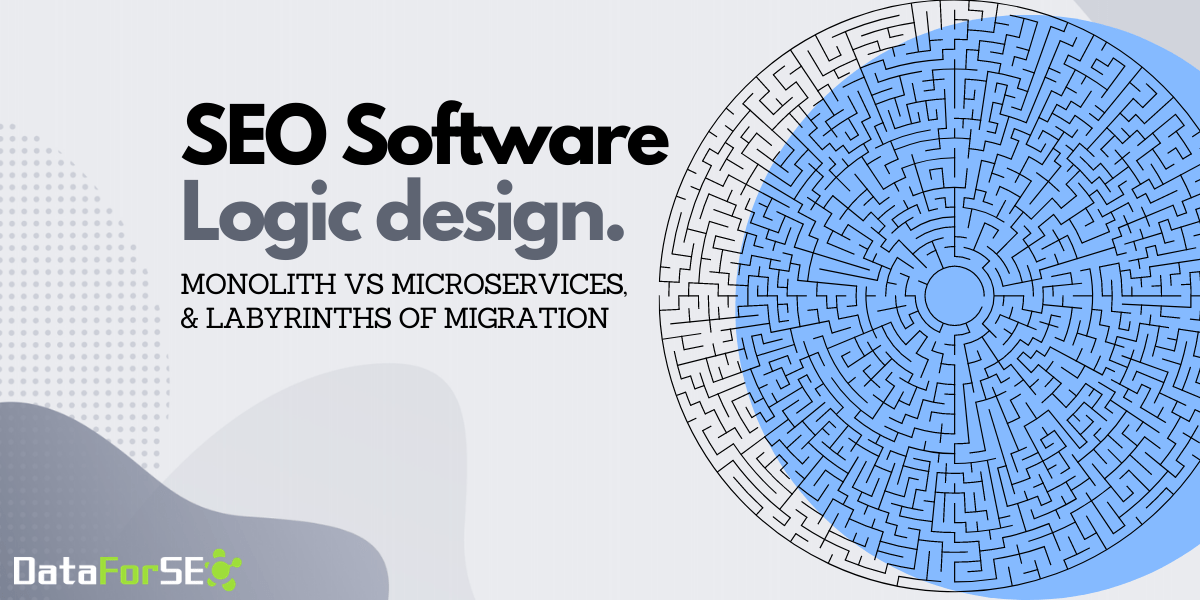
Behind any business decision and process, there should be sound logic. Same, there should be a robust logic design behind your software. The architecture layer is an essential component on top of the infrastructure that defines how parts of your software will relate to each other.
Take me there
Shedding light on monolithic vs microservices architecture
Microservices are becoming a widespread type of software architecture. However, the conventional approach of developing a piece of SEO software on top of monolithic architecture still stands, as it is easier, faster, and more affordable to deploy.
Mainly, a small and simple SEO application would be a single indivisible monolith with the MVC (Model-View-Controller) structure. The major drawback of monolithic architecture is witnessing the whole project break if something goes wrong within the system and the complexity of identifying errors or introducing changes.
On the contrary, the microservices approach focuses on building single-functioning cooperating modules. As each element has to be separately implemented, this method takes more time for deployment. With microservices, you will have more flexibility when it comes to scaling up the software or updating the functionality, as you can make the necessary modifications to specific independent parts. The same goes for breaks and errors: one issue only affects one element and can be fixed separately. In the beginning, microservices may be more complex to deal with, but they are easier to maintain, more cost-efficient, and allow for faster feature releases in the long run.
One epic journey from a monolith to microservices
Of course, if you opt for the monolithic architecture, transitioning to microservices later is possible, but the migration process is complex and lengthy.
Conductor Searchlight was initially developed as a large monolithic web application. However, the company’s engineering team faced many challenges with the monolithic architecture, as Matthew Giresi, the Director of Quality Assurance at Conductor, explained in his blog post from October 2017:
“It is complicated to develop, test, and deploy largely because of the dependencies it creates. For example, if a developer makes a change in one part of the application, we must test the entire application to ensure that everything is working properly. In addition, monolithic applications can be hard to scale vertically and horizontally. For example, attempting to increase performance in one feature usually requires us to think about the entire application as a whole. These issues affect the overall velocity and speed of our engineers, which in turn slows our ability to roll out new features, enhancements, and bug fixes to our customers.”
The company started its large-scale transition to microservices back in 2015. To minimize the risks, they went with the adoption of the Strangler pattern. It is an approach to transform a monolithic application into microservices by gradually replacing the features of the old legacy system with new functionality.
“Rather than dive right in and start pulling apart the monolith, we decided to only build things as microservices that make sense outside of the monolith,” mentioned Giresi.
Back in 2017, they still did not transition the whole application. Up till now, the engineering team at Conductor is refactoring the existing distributed systems to write the legacy systems anew.
Summary
To avoid going through the labyrinths of migration, it is better to decide beforehand if you wish to implement microservices or monolithic architecture. We recommend taking a more in-depth look at both to make the right call for your case. As a quick recap, check out the table below.
| Solution | Short run | Long run |
| Monolithic architecture | Less complex and more affordable to deploy | Complex to fix issues and scale up on |
| Microservices | Lengthy to deploy | Gives flexibility to scale and fix separate parts |
To learn more about the SEO software market characteristics, as well as current and emerging product development trends, download our FREE White Paper.